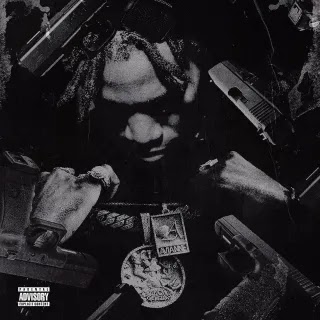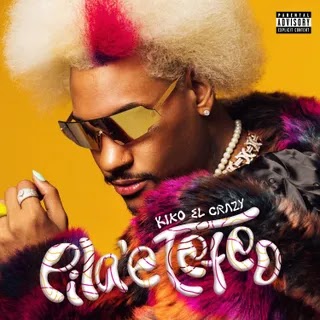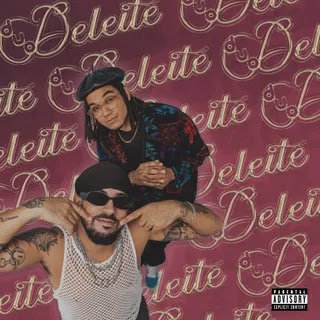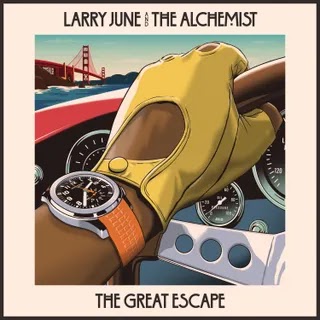Each Sunday, Pitchfork takes an in-depth look at a significant album from the past, and any record not in our archives is eligible. Today, we revisit the 2007 debut from the L.A. duo, an enchanting hip-hop classic with an almost mythological history.
By the end of the 2000s, hip-hop had completed its transformation into a dominant cultural force that dictated music, fashion, and language around the world. But the economy that made it and other pop genres so wildly profitable was crumbling. The decade that began with commercial behemoths like Country Grammar, Stankonia, and The Marshall Mathers LP ended with Department of Homeland Security officials seizing the domains of MP3 blogs. By 2007, when CD sales were just over half of what they’d been seven years prior, it was clear that the online hip-hop community had the power to break new artists by bypassing the music industry’s traditional infrastructure. This is a long way of explaining how the debut album by a relatively unknown producer and a completely anonymous MC, pressed onto only 3,500 CDs by a tiny label that would soon go out of business, became one of the signature LPs of its era.
Blu & Exile’s Below the Heavens is more than an economic curiosity. Recorded over several years in the early and mid-2000s, it channels the tactile sample chops of underground rap production at that time and the writing styles of several different subgenres from the previous decade. It is conspicuously modeled after hip-hop’s canonical debuts: rooted in autobiography, shot through with a young person’s brash ambition, its moments of vulnerability carefully parceled out and couched in redemption arcs. But it revels in tension—between its author’s parents; between his favorite MCs; between the mundanity of daily life and the divine. It’s the kind of album that made other rappers household names. And it likely would have made Blu one, too, had he shown any interest in becoming one.
Blu was born in 1983 and, as a child, moved with his mother and pastor stepfather all around greater Los Angeles, between Vernon and Inglewood, Long Beach and Azusa, even across the San Bernardino County line into Montclair. Wherever they made a home, there were strict house rules, including a ban on rap records. (A smuggled cassette of LL Cool J’s Bad was confiscated almost immediately.) While his classmates were saving their allowances to buy Doggystyle and The Chronic, young Johnson Barnes was relegated to singing in the church choir, sopping up whatever pop music bled into the sanctuary.
Around 1998, when he was in the 10th grade, Blu moved to San Pedro to live with his biological father. His dad was, well, not a pastor. (“My pop a thug,” he would later rap—“I'm a son of a Blood, with blue gators on.”) 2Pac and Too $hort filled the house. But by this point, Short Dogg was 10 albums deep and the L.A. stars of the ’90s had dimmed. Pac had been murdered in Vegas, Eazy-E had died of AIDS-induced pneumonia, Ice Cube was between halves of a poorly received double album, Snoop was recording for No Limit, and Dre had yet to make Aftermath anything more than a slightly embarrassing vanity label. Suge Knight was at a federal prison in Oregon. The iconography of the Tom Bradley era—lowriders under palm trees, jheri curls under Raiders hats—had already hardened into cliché.
The album that sparked Blu’s interest in rapping came from the opposite coast. DMX’s 1998 debut, It’s Dark and Hell Is Hot, seemed to beg imitation: It was viciously animated, frothing at the mouth. Blu would later say his earliest raps sounded like “a baby DMX” while his high school rhyming partner patterned himself after Brotha Lynch Hung, the horrorcore pioneer from Sacramento. But this ferocity was soon balanced out by influences that were more cerebral. By 2000, Blu had heard One Day It’ll All Make Sense, the Common album from 1997, and the self-titled debut EP by the Fresno rapper Planet Asia, released the year after. Over the next several years, as Blu continued to refine his style, these competing sensibilities—the swaggering id and the obsessive inward gaze—would tug at him equally.
After high school, Blu got on stage as often as he could, playing his own small shows and hosting others. He wrote constantly, but freestyled just as often, proud of his skills as a battle rapper. He was falling into an important L.A. lineage. In much the same way that the G-funk era’s imagery and local gang politics creeped into Blu’s music through osmosis and personal experience, his battle chops recalled the conscious-bent, open-mic ethos of Project Blowed and its predecessor, the Good Life Cafe. While San Pedro is some 20 miles south of the Blowed’s home in Leimert Park, Blu was meshing his showman’s instincts with that scene’s headier undertones—his raps became confrontational, but in the way that Aceyalone’s were, not MC Eiht’s.
In 2003 Blu met Aloe Blacc, the rapping and singing half of Emanon, his duo with the producer Exile. (The two were hanging with mutual friends and clicked while reciting lyrics from J. Dilla’s Welcome 2 Detroit.) Exile was working on a compilation album, and Blacc dragged him to one of Blu’s shows to scout the younger MC as someone who might contribute a couple of songs. Ex was impressed, gave Blu a pair of beats to write to, and immediately scheduled a session to cut those songs. The pair developed a quick chemistry. One night, Blu brought a Sesame Street record to Exile’s studio to sample. The muppet’s voice got laid over a lighthearted piano loop; Blu rapped, “I look like my mother, but I act like my pops did/Whatever he ain’t teach to me, the block did.” This was the beginning, in earnest, of the sessions for the hypothetical debut album that Blu had been dreaming about—and had quietly kept the name for—since the 10th grade back at San Pedro High: Below the Heavens.
It was not the only record Blu was writing at the time. Despite his pride in being a member of L.A.’s underground—the album title, aside from the obvious religious themes, is a reference to the underground/mainstream divide—Blu was not necessarily set on staying indie forever. In fact, a cousin who engineered for Death Row had put him in touch with Suge Knight, and had that label been on more solid financial footing, Blu might have filled the vacuum created by Pac’s death and Dre’s departure. Instead, he was working on a much smaller scale, cutting a playful, slightly genre-bending album with the Detroit rapper Ta’Raach and another, under the name Johnson&Jonson, with the producer Mainframe. Around this time, Blu began to have conversations with Stones Throw, the local indie giant that had just put out Madvillainy. But reps for that label told Blu they felt they could not service his commercial potential.
The J&J LP is an excellently arrogant knot of battle raps and sneering monologues, but Blu was determined to make Below the Heavens his widescreen debut, in the mold of Illmatic or Ready to Die. So Mainframe secured him and Exile a deal with Sound in Color, the indie label he founded as a teenager. The duo got to work on the album in a variety of studios around L.A. County, most frequently near the Sound in Color house in Long Beach. This is partly due to the convenience of being near a label’s headquarters, but mostly, one presumes, because Blu didn’t have a car. He would take the bus from his day job at a Long Beach pharmacy, toting the raps he had worked on during the slower parts of his shift.
It’s this sort of intrusion—real life into fantasy, bills into the best-laid plans—that gives Below the Heavens its unique texture. The album is, in some ways, built around its seventh song, the Tony Mottola-sampling “Dancing in the Rain.” Its first verse is kind of a working-class farce: It opens at 6 a.m. when Blu tries to call Exile but finds his cell phone has been cut off; carless, Blu is then victim to a slow bus schedule, which angers his boss, and his girlfriend won’t stop nagging him about money. When he finally clocks out, he doesn’t have enough change to take the bus back home, and is caught in a downpour at the stop. And then you arrive at the song’s title: a silver lining, a dance in the rain.
But what Blu does next is subvert the familiar arc he’s been tracing. After a shift spent daydreaming about the studio, he arrives there—burnt out and bitter. “Sometimes I hate taking trips to the lab,” he raps, before bluffing his way through a conversation with an impatient A&R and sheepishly admitting that, while many great artists supposedly used depression to fuel their best work, his simply makes him tired. The temptation, in any sort of dramatic writing, is to focus on acute moments of change; Blu instead writes about the crushing weight of every workday blending into the next, the death-by-a-thousand-cuts that ends so many artists’ careers before they begin.
None of which is to say that Below the Heavens is dour, or self-pitying. It never is—“Dancing in the Rain” ends with a phone call between Blu and a friend that reminds him why he enjoys writing, and that song is preceded by another, “Blu Colla Workers,” where the same types of economic stress are rendered as goofy sitcom problems. Despite describing himself as “mad at the world” on the album’s opening song, Blu spends much of it bouncing between happily placid (the sunbaked “So(ul) Amazin’ (Steel Blazin’)”) and exultant (“Show Me the Good Life”). His broad smile on the cover is not some sort of arch in-joke.
Below the Heavens’ other centerpiece, along with “Dancing in the Rain,” is “In Remembrance of Me,” a lush song meant to turn Blu’s life into myth. It doesn’t take much decoding to see what he and Exile are reaching for here: The first line Ex scratches in the chorus is from Pete Rock & CL Smooth’s “They Reminisce Over You.” In the final verse of “Remembrance,” Blu raps that his “mom thought that [he] was too young to make this song,” but this is of course the kind of song that only 22-year-olds write. It’s full of strange little tonal contradictions (he calls the girl he lost his virginity to “my first fuck” just a few bars before saying “I saw the whole world through that girl’s eyes”) and wistful recollections from just a few years prior (“We was full of youth,” he raps, “not yet abused by time”). Blu’s writing would change radically in the years to come, but on Heavens, he’s less concerned with granular details than the feelings that linger in their wake. Later on the album, he recounts not the particulars of an arrest, but the guilt he feels teaching his son about right and wrong with cuff marks fresh on his wrists.
The tonal balance and technical proficiency of Blu’s raps were mirrored by Exile behind the boards. The omnivore son and grandson of musicians, he came to hip-hop through the electro music that pumped through roller rinks and the rap broadcast throughout L.A. on KDAY. Ex had made his first mixtapes with Aloe Blacc in the mid-’90s, when both were still teenagers. By the time he met Blu, he was a dexterous veteran. His beats have, at times, been miscast as exercises in boom-bap revival, but they are better understood as an analog anchor to L.A.’s then-burgeoning beat music scene, which would soon turn toward electronic psychedelia. His scratches ground the LP in the past, while the rare digital touches keep it current: See the coda on “Show Me the Good Life,” a track that—fitting, given his partner’s influences—Exile had originally submitted to Common for inclusion on 2005’s Be.
For his part, Blu’s vocals are well served by his experience battling and his wealth of time on stage. He knows when to sink into a pocket and when to push a verse’s pace; he knows when, as at the end of “Juicen’ Dranks,” to extend a rhyme scheme in a way that elicits gasps from a crowd. He can be jagged or cascade over a beat, as he does while rattling off nuisances early on “Dancing.” He’s expressive without being a ham, charming when he tells a woman in a club that “slaves come with whips and chains/We gotta liberate!” as a way of explaining away his lack of money only a few songs after he used the whips/chains construction in earnest, on “Remembrance.”
His variety of flows also bridges some of the real and imagined fault lines between different schools of rap. His most forceful, muscular deliveries—opener “My World Is…,” “Simply Amazin’”—are actually the songs where he’s most reminiscent of Common, One Day being a more vigorously-rapped album than its reputation would suggest. And then there’s his singing. Maybe the residue of his days in church, Blu’s melodic sense on the hooks for “Blu Colla Workers,” “Dancing in the Rain,” and “The Narrow Path” makes those songs feel like complete records, and Heavens like the product of a lifetime’s worth of musical study.
Most of the lyrics on Below the Heavens are straightforward in terms of their construction and their meaning. But its most moving song, “Cold Hearted” is written elliptically, on the micro and macro level. There is domestic abuse in Blu’s childhood home and there is the death of a friend; there are weapons real and metaphorical. But Blu’s verse cagily circles each event, looping back and forth with seemingly anachronistic details and conspicuously repeating phrases. Five years after the fact, Blu told XXL that “Cold Hearted” was “the most personal record I ever recorded in my life,” an ode to the childhood sadness so deep it gave him his stage name.
By the end of 2006, after years of sessions that yielded around 50 songs, Below the Heavens was finally ready to be released, its meager first run of CDs pressed and sealed. On January 16, 2007, a SWAT team, carrying M-16s and supported by helicopters, raided the studio shared by DJ Drama and Don Cannon, two fixtures on rap’s mixtape circuit, on RICO charges. Like the websites that would be seized by ICE three years later, these mixtapes were in fact useful tools for major labels and their artists; the relationship was one of mutual benefit, not one-sided piracy. In any event, the walls were closing in around traditional brick-and-mortar sales and file-sharing blogs alike. Below the Heavens arrived just in time. Despite Blu’s ambivalence about the internet (“When we first got MySpace I was denying people I didn’t know… The label was like, ‘Yo, man, how are you gonna sell a record?’” he would later recall), the album became an instant sensation online. A single post on the hip-hop blog NahRight, Blu told me last year, made “about as much difference as it did when [Exile and I] went overseas” to tour.
Even though Sound in Color dissolved, Below the Heavens and its internet following made Blu an obvious, inevitable star in the eyes of major labels. He signed with Warner Bros. and got to work on an album. But instead of remaking Below the Heavens or writing its spiritual sequel, Blu tapped producers like Flying Lotus, Samiyam, and the Sa-Ra Creative Partners—linchpins of the beat music scene that was exploding out of Low End Theory, the weekly club night in Lincoln Heights. (In a fitting parallel to Blu’s own scene-bridging, Low End was co-founded by Nocando, the battle rapper and Project Blowed veteran.) The LP Blu recorded, originally titled NoYork!, got deprioritized during a period of corporate upheaval, but was probably too avant-garde for a major at the time anyway. A few weeks before being dropped by Warner, Blu handed out promo CDs of the nearly-finished record; it would eventually be released independently in 2013, in slightly abbreviated form and with a slightly abbreviated name, York.
For most artists, NoYork!/York would be the strangest record in their catalog, a clear outlier. For Blu, it was the most conventional thing he’d release for several years. See 2011’s j e s u s, a record so lo-fi as to give the term new meaning; see HerFavoriteColo(u)r, the self-produced dip into jazz and Blu’s DVD collection from 2009. He recorded a mostly self-produced solo album, referred to alternately as God Is Good and theGODleebarnes(lp), which is actually a natural successor to Below the Heavens—expansive, linear, autobiographical—and uploaded it to MySpace as one long MP3 under heavy distortion. And when a second Blu & Exile record finally appeared, it was with no announcement and little fanfare, as give me my flowers while i can smell them, a digital-only release. Much of this later music is superior to Heavens—richer in detail, less iterative, full of tics in writing and production that are wholly unique to Blu—but to hear fans muse about his debut, or to read much of his press, it’s as if little of it ever existed.
In many ways, Blu’s larger project is one about impermanence. His work can be hard to find; it disappears frequently, and the retail versions of NoYork! and flowers are inferior to their initial leaks. Many of his songs are buried under digital fuzz—a provocative, frequently effective choice, but one that surely shrinks his audience. And much of his most recent output, like his 2018 collaboration with Shafiq Husayn, The Blueprint, is clearly freestyled, unconcerned with persona or narrative structure. Even Below the Heavens, which seemed a conscious exception to this, has been retroactively nudged in a similar direction: its physical editions falling out of print, its files sloppily uploaded to DSPs with song titles that are incomplete or incorrect, some tracks disappearing from those platforms when permissions lapse or are lost in the shuffle. A certain kind of listener would look back at the album as a foundation that was never built on. But it could be more clearly seen as the first step on the journey that everyone and everything takes, back into the ether.
















0 comments:
Post a Comment